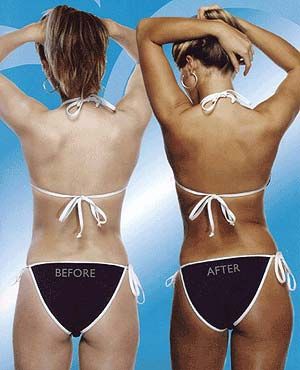In the world of beauty enhancement, spray tanning stands as a testament to how science and aesthetics brilliantly intersect. Gone are the days of orange-tinted mishaps and streaky applications. Today’s spray tanning technology harnesses sophisticated biochemistry and advanced application methods to create that coveted sun-kissed glow without UV exposure. Let’s dive into the fascinating scientific journey that happens when DHA meets your skin cells.
The Chemistry of DHA (Dihydroxyacetone)
When it comes to spray tanning, the magic happens thanks to a colorless sugar compound called dihydroxyacetone, or DHA. Here’s how it works:
- Interaction with Amino Acids: DHA reacts with the amino acids in the top layer of your skin, a process known as the Maillard reaction. This chemical reaction is similar to what happens when you sear a steak or bake bread, resulting in a browning effect that gives you that sun-kissed glow[4].
- The Maillard Reaction Explained: This reaction is entirely harmless and creates a tan that looks natural and evenly distributed. It’s the same principle that makes your cookies brown when you bake them[4].
- pH Levels and Their Impact: The pH level of your skin can affect how well the DHA reacts. Ideally, the pH should be close to the natural pH of the skin, which is slightly acidic, to ensure the best results.
- Optimal Temperature Conditions: The temperature at which the DHA is applied can also impact the reaction. Room temperature is usually ideal, as extreme temperatures can alter the rate and quality of the reaction.
- Duration of Chemical Reaction: After application, it takes around two to four hours for the tanning to begin, and the process can continue for up to 24 to 72 hours. The more DHA applied, the darker the tan will be, but it will still only last about five to 10 days due to skin cell turnover[1].
Advanced Application Technologies
Modern spray tanning is not just about splashing some solution on your skin; it involves sophisticated technology to ensure an even and flawless tan:
- Atomization Science: The solution is atomized into fine particles that evenly coat the skin. This process ensures that the DHA is distributed uniformly, preventing streaks and uneven color[4].
- Particle Size Significance: The size of the particles is crucial. Smaller particles can penetrate the skin more evenly, leading to a natural-looking tan.
- Coverage Patterns: Advanced sprayers use specific coverage patterns to ensure that every area of the skin is coated evenly. This is often done by trained technicians who understand the best application methods.
- Pressure Control Systems: The pressure at which the solution is sprayed can affect the quality of the tan. Controlled pressure ensures that the solution is applied consistently.
- Temperature-Controlled Solutions: Some solutions are temperature-controlled to optimize the chemical reaction between DHA and the skin cells. This can enhance the quality and duration of the tan.
Skin Biology and Tanning
Understanding how DHA interacts with your skin is key to a successful spray tan:
- Stratum Corneum Interaction: DHA only affects the topmost layer of the skin, known as the stratum corneum. This is why the tan is temporary and lasts only until these cells are shed[1].
- Melanin’s Role: While DHA mimics the effect of melanin (the pigment responsible for skin and hair color), it does not affect melanin production itself. Instead, it creates a pigment that adheres to the skin cells.
- Cell Turnover Effects: Since DHA affects only the outer layer of skin cells, the tan will fade as these cells exfoliate. This process typically takes five to 10 days[1].
- Moisture Barrier Function: The moisture level of your skin can affect how well the DHA reacts. Well-moisturized skin can help the DHA penetrate more evenly.
- pH Optimization: As mentioned earlier, the pH level of your skin is important. A pH level close to the natural skin pH helps in achieving the best results.
Top 5 Scientific Factors That Affect Your Spray Tan Results
Several scientific factors can influence the outcome of your spray tan:
- Skin pH Levels and Preparation Methods: Preparing your skin by ensuring it is at the right pH level can enhance the reaction between DHA and skin cells. Exfoliating and moisturizing before the application can help[4].
- Environmental Humidity and Temperature: Humidity and temperature can affect how the solution spreads and reacts on the skin. Ideal conditions are usually room temperature and moderate humidity.
- Post-Application Molecular Reaction Time: The time it takes for the DHA to fully react with the skin cells is crucial. Allowing 2-4 hours for the initial reaction and up to 24-72 hours for the full effect is recommended[1].
- Individual Skin Cell Composition: The composition of your skin cells can affect how well the DHA reacts. Some people may naturally get a better tan due to their skin’s amino acid composition.
- Solution Concentration and Formulation: The concentration of DHA in the solution and its formulation can significantly impact the results. Higher concentrations can lead to darker tans, but must be balanced to avoid uneven or too dark results.
The Future of Spray Tanning Technology
The world of spray tanning is continuously evolving, with new technologies on the horizon:
- AI-Assisted Application Systems: Future systems may use AI to analyze skin tone and optimize the application process for a perfectly customized tan.
- Custom Molecular Formulations: Personalized DHA solutions could be formulated based on individual skin types and desired tan shades.
- Smart Solution Adapting Technology: Solutions that adapt to the skin’s pH and moisture levels in real-time could improve the efficacy and longevity of the tan.
- Biocompatible Enhancers: New enhancers that are biocompatible and improve the DHA reaction could lead to more natural-looking and longer-lasting tans.
- Extended-Wear Innovations: Research into new formulations and application methods could extend the wear of a spray tan beyond the current 5-10 days.


